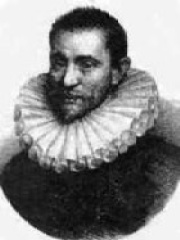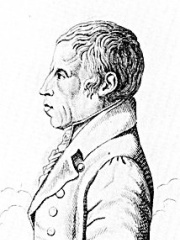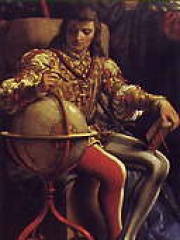
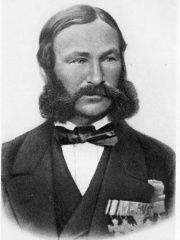
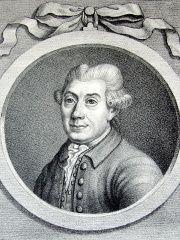
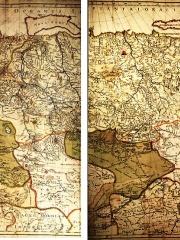
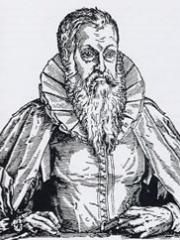
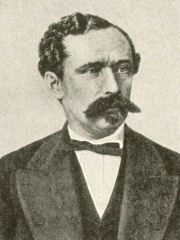
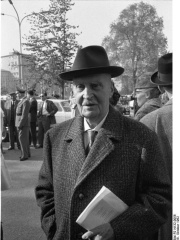
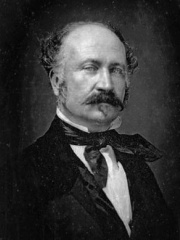
The Most Famous
EXPLORERS from Germany
Top 10
The following people are considered by Pantheon to be the top 10 most legendary German Explorers of all time. This list of famous German Explorers is sorted by HPI (Historical Popularity Index), a metric that aggregates information on a biography's online popularity. Visit the rankings page to view the entire list of German Explorers.

1. Martin Behaim (1459 - 1507)
With an HPI of 72.70, Martin Behaim is the most famous German Explorer. His biography has been translated into 36 different languages on wikipedia.
Martin Behaim (6 October 1459 – 29 July 1507), also known as Martin von Behaim and by various forms of Martin of Bohemia, was a German textile merchant and cartographer. He served John II of Portugal as an adviser in matters of navigation and participated in a voyage to West Africa. He is now best known for his Erdapfel, the world's oldest known globe, which he produced for the Imperial City of Nuremberg in 1492.

2. Heinrich Barth (1821 - 1865)
With an HPI of 67.39, Heinrich Barth is the 2nd most famous German Explorer. His biography has been translated into 39 different languages.
Johann Heinrich Barth (; German: [baʁt]; 16 February 1821 – 25 November 1865) was a German explorer of Africa and scholar. Barth is thought to be one of the greatest of the European explorers of Africa, as his scholarly preparation, ability to speak and write Arabic, learning African languages, and character meant that he carefully documented the details of the cultures he visited. He was among the first to comprehend the uses of oral history of peoples, and collected many. He established friendships with African rulers and scholars during his five years of travel (1850–1855). After the deaths of two European companions, he completed his travels with the aid of Africans. Afterwards, he wrote and published a five-volume account of his travels in both English and German. It has been invaluable for scholars of his time and since.

3. Carsten Niebuhr (1733 - 1815)
With an HPI of 67.09, Carsten Niebuhr is the 3rd most famous German Explorer. His biography has been translated into 29 different languages.
Carsten Niebuhr, or Karsten Niebuhr (17 March 1733 Lüdingworth – 26 April 1815 Meldorf, Dithmarschen), was a German mathematician, cartographer, and explorer in the service of Denmark-Norway. He is renowned for his participation in the Danish Arabia expedition (1761-1767). He was the father of the Danish-German statesman and historian Barthold Georg Niebuhr, who published an account of his father's life in 1817.

4. Philip Johan von Strahlenberg (1676 - 1747)
With an HPI of 65.60, Philip Johan von Strahlenberg is the 4th most famous German Explorer. His biography has been translated into 25 different languages.
Philip Johan von Strahlenberg (1676–1747) was a Swedish officer and geographer of German origin who made important contributions to the cartography of Russia.
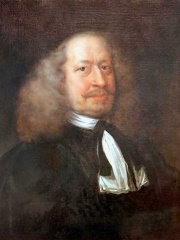
5. Adam Olearius (1603 - 1671)
With an HPI of 65.42, Adam Olearius is the 5th most famous German Explorer. His biography has been translated into 28 different languages.
Adam Olearius (born Adam Ölschläger or Oehlschlaeger; 24 September 1599 or August 16, 1603 – 22 February 1671) was a German scholar, mathematician, geographer and librarian. He became secretary to the ambassador sent by Frederick III, Duke of Holstein-Gottorp, to the Shah of Safavid (Iran), and published two books about the events and observations during his travels.

6. Hans Staden (1525 - 1579)
With an HPI of 64.83, Hans Staden is the 6th most famous German Explorer. His biography has been translated into 18 different languages.
Hans Staden (c. 1525 – c. 1576) was a German soldier and explorer who voyaged to South America in the middle of the sixteenth century, where he was captured by the Tupinambá people of Brazil. He managed to survive and return safe to Europe. In his widely read True History: An Account of Cannibal Captivity in Brazil, he claimed that the native people that held him captive practiced cannibalism.

7. Gustav Nachtigal (1834 - 1885)
With an HPI of 63.87, Gustav Nachtigal is the 7th most famous German Explorer. His biography has been translated into 27 different languages.
Gustav Nachtigal (German: [ˈɡʊstaf ˈnaxtɪɡal]; born 23 February 1834 – 20 April 1885) was a German military surgeon and explorer of Central and West Africa. He is also known as the German Empire's consul-general for Tunisia and Commissioner for West Africa. His mission as commissioner resulted in Togoland and Kamerun becoming the first colonies of a German colonial empire.

8. Duke Adolf Friedrich of Mecklenburg (1873 - 1969)
With an HPI of 63.81, Duke Adolf Friedrich of Mecklenburg is the 8th most famous German Explorer. His biography has been translated into 23 different languages.
Duke Adolf Friedrich Albrecht Heinrich of Mecklenburg-Schwerin (German: Adolf Friedrich Albrecht Heinrich, Herzog zu Mecklenburg-Schwerin; 10 October 1873 – 5 August 1969), was a German explorer in Africa, a colonial politician, and the first president of the National Olympic Committee of West Germany (1949–1951).

9. John Sutter (1803 - 1880)
With an HPI of 62.66, John Sutter is the 9th most famous German Explorer. His biography has been translated into 22 different languages.
John Augustus Sutter (February 23, 1803 – June 18, 1880), born Johann August Sutter and known in Spanish as Don Juan Sutter, was a Swiss immigrant who became a Mexican and later an American citizen, known for establishing Sutter's Fort in the area that would eventually become Sacramento, California, the state's capital. His employee James W. Marshall discovered gold, leading to the founding of the mill-making team at Sutter's Mill. Sutter, however, saw his own business ventures fail during the California gold rush, though those of his elder son, John Augustus Sutter Jr., were more successful.
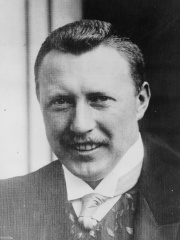
10. Wilhelm Filchner (1877 - 1957)
With an HPI of 62.40, Wilhelm Filchner is the 10th most famous German Explorer. His biography has been translated into 31 different languages.
Wilhelm Filchner (13 September 1877 – 7 May 1957) was a German army officer, scientist and explorer. He conducted several surveys and scientific investigations in China, Tibet and surrounding regions, and led the Second German Antarctic Expedition, 1911–1913. As a young military officer, Filchner gained an early reputation for dash and daring, following his travel exploits in Russia and the Pamir Mountains range. After further technical studies, he developed expertise in geography and geophysics, before leading a major scientific survey in Tibet and western China in 1903–1905. In 1909 he was appointed to organise and lead the forthcoming German expedition to the Antarctic, with both scientific and geographical objectives involving extensive exploration of the continent's interior. During the expedition his ship became trapped in the Weddell Sea ice, drifting for eight months and preventing Filchner from establishing a land base, thus failing in its main objective. Although important scientific results were obtained, the expedition was disrupted by serious interpersonal disagreements and lasting animosities, which harmed Filchner's reputation as a leader and ended his polar career. After service in the First World War he resumed his travels in Asia. He conducted two lengthy single-handed magnetic surveys in China and Tibet, often in difficult and sometimes dangerous conditions, and was continuing this work when the Second World War began, leaving him stranded in India. After years of internment, he returned to Europe and retired to Zürich, where he died in 1957. During his lifetime he received numerous honours, including the German National Prize for Art and Science in 1937, and several honorary doctorates. He is also commemorated in the Antarctic, where a number of geographical features bear his name.
People
Pantheon has 28 people classified as German explorers born between 1401 and 1877. Of these 28, none of them are still alive today. The most famous deceased German explorers include Martin Behaim, Heinrich Barth, and Carsten Niebuhr.
Deceased German Explorers
Go to all RankingsMartin Behaim
1459 - 1507
HPI: 72.70
Heinrich Barth
1821 - 1865
HPI: 67.39
Carsten Niebuhr
1733 - 1815
HPI: 67.09
Philip Johan von Strahlenberg
1676 - 1747
HPI: 65.60
Adam Olearius
1603 - 1671
HPI: 65.42
Hans Staden
1525 - 1579
HPI: 64.83
Gustav Nachtigal
1834 - 1885
HPI: 63.87
Duke Adolf Friedrich of Mecklenburg
1873 - 1969
HPI: 63.81
John Sutter
1803 - 1880
HPI: 62.66
Wilhelm Filchner
1877 - 1957
HPI: 62.40
Nikolaus Federmann
1505 - 1542
HPI: 61.52
Julius Klaproth
1783 - 1835
HPI: 61.14
Overlapping Lives
Which Explorers were alive at the same time? This visualization shows the lifespans of the 19 most globally memorable Explorers since 1700.

